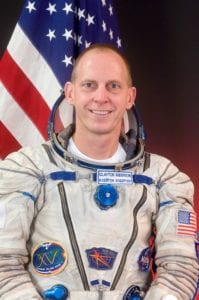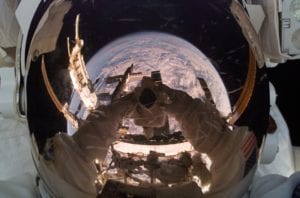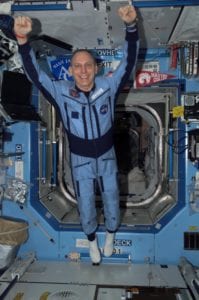The Ordinary Spaceman: Clayton Anderson
 From a young age, Clayton Anderson knew he wanted to be an astronaut. “My mom would tell you, if she were still around, that when I was six we often discussed that I wanted to be an astronaut,” he said. He recalled the story of his participation in his hometown’s summertime carnival, before superstores started stocking Halloween costumes, and wearing a homemade astronaut suit. “Getting a costume was a little more difficult and required a little more creativity, so my mom hopped in the pantry and grabbed her Reynolds aluminum foil and grabbed a hat box out of her closet,” he noted. “She cut a hole for my head, a slot for my eyes, and fastened the top of the hat box on. She put a pipe cleaner in a Styrofoam ball at the top so I could communicate with aliens, and I marched as a Mercury astronaut in the [Ashland, Nebr.] Stir Up when I was six.” Since then, Clayton has worn a more official astronaut uniform – during his time at NASA, he spent five months on the International Space Station – but he still remembers the story of his hometown parade with great pride. “And I didn’t win, that’s what was bad,” he laughed. “I got beat by Toto and somebody dressed like Dorothy. I think she had a real dog in her picnic basket. That’s what did it.”
From a young age, Clayton Anderson knew he wanted to be an astronaut. “My mom would tell you, if she were still around, that when I was six we often discussed that I wanted to be an astronaut,” he said. He recalled the story of his participation in his hometown’s summertime carnival, before superstores started stocking Halloween costumes, and wearing a homemade astronaut suit. “Getting a costume was a little more difficult and required a little more creativity, so my mom hopped in the pantry and grabbed her Reynolds aluminum foil and grabbed a hat box out of her closet,” he noted. “She cut a hole for my head, a slot for my eyes, and fastened the top of the hat box on. She put a pipe cleaner in a Styrofoam ball at the top so I could communicate with aliens, and I marched as a Mercury astronaut in the [Ashland, Nebr.] Stir Up when I was six.” Since then, Clayton has worn a more official astronaut uniform – during his time at NASA, he spent five months on the International Space Station – but he still remembers the story of his hometown parade with great pride. “And I didn’t win, that’s what was bad,” he laughed. “I got beat by Toto and somebody dressed like Dorothy. I think she had a real dog in her picnic basket. That’s what did it.”
Clayton’s memory of fascination with space flight continued through his childhood. “On Christmas Eve in 1968, around midnight, Mom and Dad woke my brother and sister and me and put us in front of a black and white TV on the floor,” he remembered. “We watched the Apollo 8 astronauts go behind the moon for the first time in history.”
The path for Nebraska’s first – and so far, only – astronaut wasn’t as smooth as those stories make it seem. Clayton joined the Johnson Space Center in 1983 after finishing his Master of Science in Aerospace Engineering, and moved to the Mission Operations Directorate (MOD) in 1988 as a Flight Design Manager. During that time, he applied for the astronaut program 15 times before he was chosen in June 1998. “I was an engineer at NASA for at least 13 of the 15 years,” he recalled. “We were working on some pretty cool stuff: the station hadn’t been built yet, and the shuttle was moving toward a semi-operational phase where we were launching quite regularly and putting satellites in space.” Clayton’s work was fulfilling, and even though the thought of 15 rejected applications might have turned others away, but his Midwest work ethic saw him through. “I had gainful employment within my group, and I was contributing to the mission,” he said. “I tried to continue to work hard and do the right thing, impress my bosses if I could, and hope that enough people recognized my contributions so maybe I’d get a shot later.”

A “selfie” Anderson took during his time on the International Space Station during a lighter moment.
Clayton came closer to his goal in 1996, and made it to the interview portion of the application. He took an opportunity for job growth after his 13th rejection – and credits that move today with helping him to be better known with the selection committee. “I’d been working on space stuff forever and it wasn’t getting me very far with my astronaut application,” he noted. “I made a decision to change jobs and become the manager of Johnson Space Center’s emergency operations center, which meant I was now not going to deal with space but I was going to deal with hurricanes, bomb threats, toxic spills, fires, and security breaches – all that kind of stuff. I think that it was one of the keys that helped me get enough exposure to the right people so that when I interviewed the next time, they knew who I was and had an idea of what I was capable of, both in engineering and in leadership.” Clayton is quick to downplay his hard work when talking about his accomplishments. “That’s lucky, is what it is,” he said. “I tell people a lot that applying to be an astronaut is easy, getting picked is hard.”
Clayton was assigned to the crew of STS-118, scheduled to go to the International Space Station in August 2007. He had completed much of his training with that crew, getting to know them and how to work with them, when he was told “last minute” that he would instead launch with the crew of STS-117. “Essentially, they were going to launch me into space, keep me for a day, and then once we docked with the space station they were going to push me through the hatch and I was going to become the space station guy,” he recalled. “The nice thing about NASA’s training is that it’s pretty consistent no matter what crew you’re assigned with.” Once on board the ISS, Clayton was one of three on board. “At the time, I was one American with two Russians,” he recalled. As the only American, Clayton served as science officer for the U.S. side. “I was responsible for several different experiments to make sure they were running properly: I would set them up if they were new, change out samples as appropriate, send the data to the ground, all that kind of stuff. Much like Mr. Spock was on Star Trek,” he laughed.

Anderson shows off his Superman skills aboard the ISS.
Adapting to weightlessness and the everyday act of living in the space station took a little while – like learning how to eat without gravity. “Most of the tasks get easier as you adapt to weightlessness and the ability to use tools and move around and stabilize yourself,” Clayton recalled. “At first it’s a little awkward and then you get into a groove and learn the tricks of the trade.” Clayton recalled the kindness of the Russian cosmonauts on board the space station, who gave him tips to help him adapt. Once he was used to the environment, he said, it was one of his favorite aspects of being in space. “I was Superman every day,” he said wistfully. “I could fly, I could spin, I had super strength.” Clayton jokingly lamented his lack of X-ray vision and super-hearing, but advised that being able to see the earth from above was his other favorite part of his time on the ISS. “It gives you a chance to reflect a little bit, and it strengthened my faith in God, because it’s just so amazing to look out that window and see the place where humans live and work and play and do wonderful things in a place that has beautiful, deadly deserts; rain forests; mountain ranges,” he recalled. “It’s an impressive place, and to see it from space, many of us get the perspective of ‘Yes, we should protect the earth more,’ and that’s true, but what struck me the most was that I believed it was put together by a higher power than me.”
Clayton often reminded the others on board and back at mission control that he was Nebraska’s first and only astronaut to date. He listed “Famous Cities from Nebraska” daily, and his love of his home state was so evident that Fyodor Yurchikhin, the Russian commander on board with Clayton, named two satellites after Clayton’s home state. “[They were] outdated parts of the ISS, both items I jettisoned during a 7 hour and 41-minute spacewalk (EVA) on July 23, 2007,” Clayton explained. Keeping up his connection to Nebraska helped Clayton feel grounded, in a way, and also gave him a way to help inspire future Nebraskans to follow in his flight plan. “I was homesick at times and doing something for my state like calling out Famous Cities from Nebraska wasn’t only fun for me. I wanted elementary school teachers to tell their class, ‘Did you know that Holdrege was mentioned on the International Space Station on October 13, 2007 by Nebraska’s first and only astronaut, Clayton Anderson?’ I wasn’t trying to make people know about me, I was trying to expose people to my feelings of how great my home state is,” he explained. “I am proud to be Nebraska’s first and only astronaut, and I certainly hope I am not her last.”
Related Stories
Cheers to 20 Years
Six members of Team Jet Linx celebrate two decades of Five-Star service.
READ MORE
Immerse Yourself
More than 40 years after pioneering one of the first health and wellness resorts in Tucson, AZ, Jet Linx Elevated Lifestyle partner Canyon Ranch continues to redefine what wellness-focused getaways can offer.
READ MORE
What Kind of Caviar Are You?
Whether you are a caviar newbie or a seasoned connoisseur, Jet Linx Elevated Lifestyle partner Petrossian has a caviar for your tastes.
READ MORE
Related Stories
Cheers to 20 Years
Six members of Team Jet Linx celebrate two decades of Five-Star service.
READ MORE
Immerse Yourself
More than 40 years after pioneering one of the first health and wellness resorts in Tucson, AZ, Jet Linx Elevated Lifestyle partner Canyon Ranch continues to redefine what wellness-focused getaways can offer.
READ MORE
What Kind of Caviar Are You?
Whether you are a caviar newbie or a seasoned connoisseur, Jet Linx Elevated Lifestyle partner Petrossian has a caviar for your tastes.
READ MORE



Contact Us